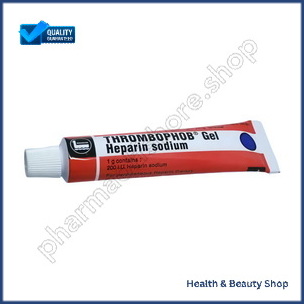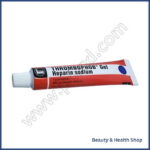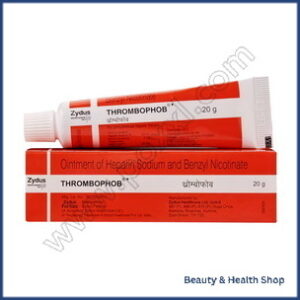ADDICTION
ALCOHOL DEPENDENCE
QUIT SMOKING
ALLERGY
ANTI FUNGAL
FUNGAL INFECTION
FUNGAL NAIL INFECTIONS
ANTI-REJECTION DRUGS
ANTI WORM
ANTIBIOTIC
BACTERIAL INFECTIONS
ARTHRITIS
GOUT
OSTEOARTHRITIS
RHEUMATOID ARTHRITIS
BLOOD
LOW PLATELET COUNT
THROMBOPHLEBITIS
VARICOSE VEINS
COLON
ANAL FISSURE
PILES
ULCERATIVE COLITIS
DIABETES CARE
DIABETES INSIPIDUS
DIABETES TYPE
DIABETIC FOOT ULCERS
GLUCOSE MONITOR
EYES/EAR CARE
DRY EYES
EYE CARE
EYE EXAMINATION
EYE INFECTION
EYE LASHES
EYE PAIN
GLAUCOMA
OCULAR HYPERTENSION
UVEITIS
FEVER CARE
MALARIA
RHEUMATIC FEVER
TYPHOID FEVER
GASTROINTESTINAL
ACIDITY
CONSTIPATION
CROHN'S DISEASE
DIARRHOEA
GALLBLADDER STONES
INTESTINAL ULCERS
IRRITABLE BOWEL SYNDROME
MOTION SICKNESS
NAUSEA
Thrombophob Gel (Heparin Sodium)
| Active Ingredient (Generic Name): | Heparin Sodium |
|---|---|
| Indication: | Thrombophlebitis, Piles, Anal fissure |
| Manufacturer: | Zydus Cadila Pharma |
| Packaging: | 20 gm in one tube |
| Strength: | 20g |
From: $31.00
Thrombophob Gel contains heparin sodium and is used topically to prevent and treat blood clots and inflammation in veins, especially in cases of superficial thrombophlebitis. It is applied directly to the affected area to reduce clot formation and alleviate symptoms. By inhibiting clot formation, Thrombophob Gel helps manage superficial thrombophlebitis, promoting skin healing and enhancing recovery. Its benefits include preventing blood clot formation, reducing pain and swelling, and treating various thrombotic disorders. Further exploration of Thrombophob Gel reveals its potential in combating thrombosis and supporting vascular health.
Main Points
- Thrombophob Gel comprises heparin sodium, which impedes clot formation and eases superficial thrombophlebitis symptoms.
- Through topical application, Thrombophob Gel diminishes clotting risk, pain, and swelling, fostering skin recovery.
- The gel is suitable for conditions such as deep vein thrombosis, pulmonary embolism, atrial fibrillation, and cardiac valve replacement.
- Contraindications involve active bleeding, thrombocytopenia, heparin hypersensitivity, and severe hypertension.
- Thrombophob Gel’s topical use ensures prompt absorption, swift relief, and minimal adverse effects, positioning it as a preferred treatment choice.
What Is Thrombophob Gel Used for
Thrombophob Gel, containing heparin sodium, is prescribed to prevent and treat superficial thrombophlebitis, a condition characterized by blood clots and inflammation in superficial veins. This topical gel is applied directly to the affected area to reduce the risk of blood clots and alleviate symptoms such as pain, swelling, redness, and warmth in the legs. It is particularly effective in treating superficial thrombophlebitis caused by various factors like trauma, immobilization, or underlying medical conditions. Applying Thrombophob Gel as directed by your doctor can help manage the condition and prevent complications associated with blood clots.
How Heparin Sodium Works Topically
Thrombophob Gel containing heparin sodium inhibits clot formation by blocking thrombin, inactivating clotting factors, and enhancing anticoagulant activity through antithrombin III activation. This process reduces fibrin formation, dissolving existing clots. By comprehending heparin sodium’s mechanism, users can grasp the benefits of using Thrombophob Gel for conditions like superficial thrombophlebitis.
Benefits of Thrombophob Gel Treatment
When using Thrombophob Gel treatment, you can experience various advantages. This topical application helps prevent the formation of blood clots, reduces pain and swelling, and promotes skin healing. Overall, Thrombophob Gel can significantly enhance the recovery process.
Prevents Blood Clots Formation
Thrombophob Gel treatment helps prevent serious health complications by inhibiting blood clot formation. The active ingredient, heparin sodium, blocks the production of thrombin, a crucial enzyme in blood clotting. This action reduces the risk of conditions like deep vein thrombosis, pulmonary embolism, and stroke. Using Thrombophob Gel can safeguard your health by minimizing the potential long-term damage to your blood vessels and organs. Whether recovering from surgery, injury, or immobility, using Thrombophob Gel offers proactive protection against blood clot-related risks.
Reduces Pain and Swelling
Thrombophob Gel containing heparin sodium not only prevents blood clot formation but also helps alleviate pain and swelling in the affected area, facilitating a more comfortable recovery process. The application of the gel reduces inflammation, leading to decreased pain and swelling. This anti-inflammatory effect aids in breaking down existing clots, lowering the risk of complications. By diminishing discomfort and stiffness, it enhances mobility and ease of movement. Moreover, the gel’s pain-relieving properties contribute to easing emotional distress linked to pain, fostering a more positive recovery journey. Thrombophob Gel‘s ability to reduce pain and swelling supports the restoration of mobility and confidence, enabling a quicker return to daily activities. With its dual action of preventing blood clots and alleviating pain and swelling, Thrombophob Gel proves to be an effective treatment for managing venous thrombosis and promoting a seamless recovery.
Enhances Skin Recovery
Thrombophob Gel treatment accelerates skin recovery by promoting collagen synthesis and enhancing skin elasticity. This results in improved skin texture, tone, and reduced appearance of fine lines and wrinkles. The active ingredient, heparin sodium, stimulates growth factors for tissue repair and regeneration, leading to faster wound closure and reduced scarring. Thrombophob Gel significantly reduces recovery time, making it an effective option for enhancing skin recovery and achieving healthier skin.
Preventing Blood Clots With Thrombophob
Preventing blood clots with Thrombophob gel involves applying a specific amount of heparin sodium to the affected area. This action helps to inhibit clot formation and decrease the risk of thrombotic complications. The absorption of heparin sodium into the affected tissue when applying Thrombophob gel can effectively prevent blood clotting, particularly important in situations where there is a heightened risk of clot development, such as post-surgery or during extended periods of immobility.
Indications and Contraindications
Understanding the contraindications for heparin is essential when considering the use of Thrombophob Gel for preventing blood clots in medical and surgical patients. It is important to take into account conditions such as bleeding disorders and recent surgery when making decisions about prophylactic treatment options.
Therapeutic Uses
Heparin sodium, the active ingredient in Thrombophob Gel, is indicated for the prophylaxis and treatment of deep vein thrombosis, pulmonary embolism, arterial thromboembolism, and clotting during certain medical procedures. It is also used for preventing thromboembolic complications in patients with specific conditions such as atrial fibrillation, cardiac valve replacement, and ischemic heart disease. Thrombophob Gel is versatile in its therapeutic applications, focusing on the prevention and management of various blood clot-related issues.
Heparin Contraindications List
When using Thrombophob Gel, it is important to be aware of situations where heparin sodium should not be used. Avoid using heparin sodium in patients with active bleeding, hemorrhage, bleeding disorders, thrombocytopenia, severe hypertension, or recent surgery to prevent increased bleeding risks. It is also contraindicated in patients with known hypersensitivity to heparin or pork products, and caution should be taken in patients with kidney or liver disease due to potential metabolism and excretion issues. Evaluating the risks and benefits in each patient is crucial, and alternative treatments should be considered when necessary to minimize adverse reactions and ensure effectiveness.
Prophylactic Treatment Options
Consider prophylactic treatment options for patients at high risk of venous thromboembolism, such as those undergoing major surgery, experiencing trauma, or with a history of thrombosis. Evaluate individual risk factors like age, mobility, and medical history to determine the most appropriate duration of prophylaxis. Tailor dosing regimen and administration route (e.g., subcutaneous or intravenous) based on the patient’s needs and medical history.
Thrombophob Gel Side Effects
Patients using Thrombophob Gel may experience mild to moderate side effects, such as skin reactions, bruising, or bleeding at the application site. Symptoms like redness, swelling, or itching are common and typically resolve within a few days. In rare instances, more severe reactions like severe bruising, bleeding, or skin necrosis may occur. If these symptoms arise, discontinue use and seek advice from a healthcare provider. Watch for signs of allergic reactions, such as hives, difficulty breathing, or swelling of the face, lips, tongue, or throat.
It is important to weigh the benefits of using Thrombophob Gel against the potential risks. If you have concerns about side effects, consult your healthcare provider for guidance tailored to your specific condition. Adhering to the recommended application instructions and dosage is crucial in minimizing the risk of adverse effects.
Dosage and Administration Guidelines
To ensure safe and effective treatment with Thrombophob Gel, it is crucial to adhere to specific dosage instructions. Carefully follow the recommended guidelines for applying the gel to reduce the risk of complications. Understanding the correct dosage and administration procedures can help minimize potential risks and optimize the therapeutic benefits of this medication.
Dosage Recommendations
For the safe and effective use of Thrombophob Gel, carefully follow the product labeling and seek advice from a healthcare provider for proper dosage guidance.
Typically, for preventing deep vein thrombosis, administer 5,000-7,500 units of Thrombophob Gel subcutaneously every 8-12 hours. In treating venous thromboembolism, the usual dosage is 10,000-20,000 units subcutaneously every 12 hours.
Considerations for dosage adjustment include body weight, renal function, and other relevant factors. Platelet count monitoring is essential to prevent thrombocytopenia. Adherence to the recommended dosage and schedule is crucial for the safe and effective use of Thrombophob Gel.
Administration Precautions
To ensure the safe and effective administration of Thrombophob Gel, it is important to follow specific precautions. Before applying the gel, carefully examine the affected area for any signs of infection, injury, or irritation. Do not use the gel if any of these conditions are present, and avoid applying it to broken skin or mucous membranes.
When applying the gel, wear gloves to prevent the risk of bleeding or bruising. Apply the gel only to the affected area, avoiding healthy surrounding skin, and be gentle to prevent potential bleeding or bruising.
After application, monitor the area for any signs of bleeding, bruising, or irritation. If any adverse reactions occur, discontinue use and seek advice from a healthcare professional. Adhering to these administration precautions will help ensure the safe and effective use of Thrombophob Gel.
Thrombophob Gel Vs Other Treatments
Thrombophob Gel, a topical heparin sodium gel, offers advantages over other treatments for superficial thrombophlebitis. Its topical application allows for rapid absorption into the affected area, providing quick relief. With minimal side effects and easy application, Thrombophob Gel is a convenient and safe option for patients seeking relief from superficial thrombophlebitis symptoms.
Managing Thrombosis Risk Factors
Identifying and addressing underlying risk factors is essential to preventing thrombosis, as certain conditions and lifestyle habits can significantly increase the likelihood of developing blood clots. Managing these risk factors is crucial for reducing the chances of developing deep vein thrombosis (DVT) and pulmonary embolism (PE).
| Risk Factor | Description |
|---|---|
| Immobility | Extended periods of inactivity, like during long flights or bed rest, can elevate the risk of blood clot formation. |
| Genetics | A family history of thrombosis or clotting disorders can heighten the risk of developing blood clots. |
| Hormonal Birth Control | Some hormonal birth control methods, such as oral contraceptives, can increase the risk of blood clot formation. |
Common Conditions Treated With Thrombophob
Thrombophob Gel, containing heparin sodium, is commonly used to treat and prevent various thrombotic disorders, including deep vein thrombosis, pulmonary embolism, and atrial fibrillation. Thrombophob Gel is prescribed to manage arterial thrombosis, venous thromboembolism (VTE), and unstable angina.
Safety Precautions and Interactions
When using Thrombophob Gel, it is crucial to consider potential interactions with other medications and certain health conditions that could heighten the risk of adverse reactions. Inform your healthcare provider about all current medications, including vitamins and supplements, as they may interact with heparin sodium in the gel. Combining Thrombophob Gel with anticoagulant drugs like warfarin may elevate the risk of bleeding.
Exercise caution if you have health conditions such as bleeding disorders, kidney or liver disease, or low blood platelet count. If you are pregnant or breastfeeding, consult your healthcare provider before using Thrombophob Gel, as its safety in these circumstances is not fully established. Regularly monitor your platelet count while using the gel, as it could potentially lead to thrombocytopenia, characterized by low platelet count. By being mindful of these interactions and health conditions, you can reduce the risk of adverse reactions and ensure the safe and effective use of Thrombophob Gel.
How to Apply Thrombophob Gel Correctly
To properly apply Thrombophob Gel, gently spread a thin layer over the affected area using smooth, sweeping motions. This ensures even distribution of the product and enhances the effectiveness of its active ingredient, heparin sodium. Remember to wash your hands before and after application to prevent bacteria from contaminating the area. Avoid applying the gel on broken or irritated skin to reduce the risk of adverse reactions. Massage the gel gently into the skin until fully absorbed, being careful not to apply too much pressure.
Frequently Asked Questions
Is Thrombophob Gel Safe to Use During Pregnancy or Breastfeeding?
When considering topical anticoagulants during pregnancy or breastfeeding, caution is advised. It is generally recommended to avoid using such products during these times without close medical supervision. Consult your doctor for guidance, as they will assess the benefits and potential risks based on your specific situation and medical history. Prioritize your health and that of your baby at all times.
Can I Use Thrombophob Gel on Open Wounds or Cuts?
Thrombophob gel should not be applied on open wounds or cuts. Heparin, the active ingredient in the gel, is primarily used to prevent blood clots, rather than promote wound healing. Using heparin on open wounds can actually slow down the healing process and increase the risk of bleeding. It is important to focus on keeping the wound clean and dry, and it is advisable to seek advice from a healthcare professional for proper wound care.
Will Thrombophob Gel Stain Clothing or Bedding?
When using Thrombophob Gel, it’s natural to be concerned about potential stains on clothing or bedding. Typically, water-based gels are less likely to cause staining, but caution is still advised. In case of accidental contact with fabric, promptly blot the affected area with cold water and mild soap to reduce the chance of staining. Always adhere to the product’s specific guidelines and recommended precautions to prevent any potential staining issues.
Can I Use Thrombophob Gel on Children or Infants?
When considering using a topical gel on children or infants, it is important to consult a pediatrician or healthcare professional to evaluate the potential risks and benefits. Always adhere to the product’s instructions and seek guidance from a doctor if uncertain. For children, weighing the advantages against potential risks is essential, and seeking advice from a medical professional can help in making an informed decision.
Is Thrombophob Gel Available Over-The-Counter or by Prescription Only?
Thrombophob Gel, containing heparin sodium, is typically available by prescription only due to the potency of heparin sodium as an anticoagulant. The need for careful monitoring and dosage adjustments makes it unlikely to be found over-the-counter without a doctor’s prescription.
Conclusion
You have successfully integrated Thrombophob gel into your treatment plan, utilizing the benefits of heparin sodium to prevent blood clots and manage thrombosis risk factors. By following the application instructions and understanding the indications, contraindications, and potential interactions, you are well-prepared to reduce the risk of thrombotic events. With consistent use, Thrombophob gel can play a crucial role in your comprehensive approach to thrombosis management.





There are no reviews yet.